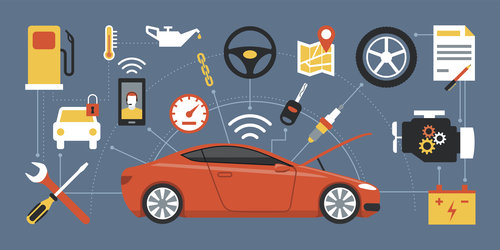
27/02/2017
Tires, the new “gauge” for motor vehicles
Paolo Ferrini
“Intelligent” tires thanks to cutting-edge sensors placed in the tread. Microchips able to detect the conditions of the road, the surrounding environment and to monitor pressure and temperature in order to adapt the behavior of the vehicle. These are just some of the changes that are already affecting the automotive sector and will soon become everyday reality.
If, as we often say, the tire is really "the only element that connects a vehicle to the road surface", what better option is there to collect reliable information about the behavior and condition of a vehicle and send it to the driver in real time? Such observations gave birth to a number of new proposals that, by taking advantage of both the inherent characteristics of tires and what is offered in terms of advanced electronic systems, are transforming the way tires, vehicles and even drivers are monitored and subsequently managed.
Towards the end of the Twentieth Century, those first few sensors placed inside the wheels which monitored tire pressure and reported the results to anyone driving a car equipped with run-flat tires led the way. However, once these devices, also known as Tpms (Tire pressure monitoring system), were joined by indirect systems – so called Dds (Deflation detection system) – often linked to Abs devices and able to detect any loss of pressure monitoring the rotational speed of the wheel, the development process currently taking place before our eyes got underway.
Once established that a tire was losing pressure, not much else could be done apart from reaching, as soon as possible, the nearest tire shop. In order to get around this problem, a few years ago Goodyear developed a system capable of maintaining and automatically restoring the correct tire pressure and called it AMT (Air maintenance technology), a special inflation system which used a miniature pump lodged inside the tires. The AMT system works as a peristaltic pump: when the wheel turns, a small tube containing air inside the tire bead is squeezed by the weight of the car throughout its length blowing air towards the opposite end of the tire thus increasing the pressure. Before entering the tire, the air goes through a small valve that regulates the correct pressure and prevents it from escaping the tire at the same time.
The Michelin Auto Inflate System, on the other hand, was specifically designed for trucks and uses a Halo device manufactured by a US company named Aperia Technologies which can be assembled in 10 minutes on the wheel hub. The device monitors and regulates the tire pressure at each wheel rotation and can be set to a desired pressure right by the factory and can easily be transferred from one vehicle to another.
Still with a view to optimizing the use of tires through new technologies, Nokian came up with a prototype of a winter tire ready to be equipped with studs on request: at the push of a button on the dashboard, in fact, studs come out of the tread. This guarantees grip in extremely slippery conditions (and therefore safety) while the retractable studs go back in the tire in dry and stable winter conditions ready to be activated again if necessary.
So far we have taken a look at technological solutions aimed at making the best use of tires. However, since, as they say, appetite comes with eating, some researchers have also considered using tires also to enhance vehicle performance. So three years ago, at the 2014 Geneva Motor Show, Goodyear/Dunlop unveiled the prototype of a tire equipped with a microchip connected to an onboard computer. This system, developed in partnership with Huf, one of the leading manufacturers of electrical and mechanical clamping, pressure monitoring and computerized systems for the automotive industry, is able to send, in real time, information about tire pressure and temperature to an electronic control unit which automatically develops a set of algorithms to improve lateral and longitudinal handling thus improving driving performance. The data gathered is sent to the on-board computer which reduces the braking distance when the Abs system kicks into action, improves cornering grip, ensures a greater yaw stability and optimized stability control systems.
Following up on this Chip-in-Tire Technology, a couple of years later Goodyear went on to introduce IntelliGrip, a system that provides for a tire with sensors lodged inside the tread which are able to detect the conditions of the road surface and the surrounding environment so as to adjust the behavior of the vehicle on the basis of information coming directly from the tires. IntelliGrip is able to monitor both weather and road conditions as well as the tire, sending the data to the vehicle’s on-board computer that will adjust the speed according to the information received, reducing braking distance, improving cornering precision and support anti-collision systems.
Meanwhile, as we wait for all this to become a reality for the average motorist, some manufacturers such as Goodyear and Michelin have decided to make the best use of these technologies in the transport sector. "Managing tires efficiently is a major challenge, especially for Italian fleets, which are called upon to face, on a daily basis, a variety of road conditions and at times quite difficult”, says Antonio Calabretta, Commercial Director Truck Business Unit for Goodyear Dunlop Italy. "Thanks to Proactive Solutions, we will be able to ensure our fleets a total monitoring system, avoiding most of the issues related to tires thus greatly reducing operational costs".
The technological innovation that characterizes Proactive Solutions is a predictive algorithm combined with advanced telematics. The program is divided into two different groups of services: Proactive Tire which focuses on managing data coming from the tire and Proactive Fleet which works on information relating to the performance of the driver and the position of the vehicle. In turn these two services are made up of as many other specific services: the first provides for a Tpms with Rfid sensors on each wheel to measure the pressure and temperature of each tire. Any Poorly inflated and/or overheated tires are promptly reported in order to carry out immediately the necessary preventive action and prompt assistance, if needed, within 120 minutes after reporting.
The benefits are the same as those linked with every Tire Pressure Monitoring System: reduced fuel consumption as a result of under-inflation, reduced vehicle downtime due to tire damage and consequent longer life span. Still according to Goodyear, such preventive maintenance has enabled customers fleet to reduce by 75% the number of breakdowns and accidents linked to tires.
On a very similar path we find Michelin Solutions, which, through a series of on-board electronic systems aims to make industrial vehicles more efficient with its Effitires, Effifuel and Effitrailer services. “Fuel accounts for 30-40% of all operating costs in a fleet", says Mauro Perin, Commercial Director of Michelin Solutions, "Michelin Solutions is committed by contract to enhance efficiency and, if the goals are not achieved, we will refund the client proportionally to the costs incurred". What can we say, once again tires and technology at the service of the average motorist.
Towards the end of the Twentieth Century, those first few sensors placed inside the wheels which monitored tire pressure and reported the results to anyone driving a car equipped with run-flat tires led the way. However, once these devices, also known as Tpms (Tire pressure monitoring system), were joined by indirect systems – so called Dds (Deflation detection system) – often linked to Abs devices and able to detect any loss of pressure monitoring the rotational speed of the wheel, the development process currently taking place before our eyes got underway.
Once established that a tire was losing pressure, not much else could be done apart from reaching, as soon as possible, the nearest tire shop. In order to get around this problem, a few years ago Goodyear developed a system capable of maintaining and automatically restoring the correct tire pressure and called it AMT (Air maintenance technology), a special inflation system which used a miniature pump lodged inside the tires. The AMT system works as a peristaltic pump: when the wheel turns, a small tube containing air inside the tire bead is squeezed by the weight of the car throughout its length blowing air towards the opposite end of the tire thus increasing the pressure. Before entering the tire, the air goes through a small valve that regulates the correct pressure and prevents it from escaping the tire at the same time.
The Michelin Auto Inflate System, on the other hand, was specifically designed for trucks and uses a Halo device manufactured by a US company named Aperia Technologies which can be assembled in 10 minutes on the wheel hub. The device monitors and regulates the tire pressure at each wheel rotation and can be set to a desired pressure right by the factory and can easily be transferred from one vehicle to another.
Still with a view to optimizing the use of tires through new technologies, Nokian came up with a prototype of a winter tire ready to be equipped with studs on request: at the push of a button on the dashboard, in fact, studs come out of the tread. This guarantees grip in extremely slippery conditions (and therefore safety) while the retractable studs go back in the tire in dry and stable winter conditions ready to be activated again if necessary.
So far we have taken a look at technological solutions aimed at making the best use of tires. However, since, as they say, appetite comes with eating, some researchers have also considered using tires also to enhance vehicle performance. So three years ago, at the 2014 Geneva Motor Show, Goodyear/Dunlop unveiled the prototype of a tire equipped with a microchip connected to an onboard computer. This system, developed in partnership with Huf, one of the leading manufacturers of electrical and mechanical clamping, pressure monitoring and computerized systems for the automotive industry, is able to send, in real time, information about tire pressure and temperature to an electronic control unit which automatically develops a set of algorithms to improve lateral and longitudinal handling thus improving driving performance. The data gathered is sent to the on-board computer which reduces the braking distance when the Abs system kicks into action, improves cornering grip, ensures a greater yaw stability and optimized stability control systems.
Following up on this Chip-in-Tire Technology, a couple of years later Goodyear went on to introduce IntelliGrip, a system that provides for a tire with sensors lodged inside the tread which are able to detect the conditions of the road surface and the surrounding environment so as to adjust the behavior of the vehicle on the basis of information coming directly from the tires. IntelliGrip is able to monitor both weather and road conditions as well as the tire, sending the data to the vehicle’s on-board computer that will adjust the speed according to the information received, reducing braking distance, improving cornering precision and support anti-collision systems.
Meanwhile, as we wait for all this to become a reality for the average motorist, some manufacturers such as Goodyear and Michelin have decided to make the best use of these technologies in the transport sector. "Managing tires efficiently is a major challenge, especially for Italian fleets, which are called upon to face, on a daily basis, a variety of road conditions and at times quite difficult”, says Antonio Calabretta, Commercial Director Truck Business Unit for Goodyear Dunlop Italy. "Thanks to Proactive Solutions, we will be able to ensure our fleets a total monitoring system, avoiding most of the issues related to tires thus greatly reducing operational costs".
The technological innovation that characterizes Proactive Solutions is a predictive algorithm combined with advanced telematics. The program is divided into two different groups of services: Proactive Tire which focuses on managing data coming from the tire and Proactive Fleet which works on information relating to the performance of the driver and the position of the vehicle. In turn these two services are made up of as many other specific services: the first provides for a Tpms with Rfid sensors on each wheel to measure the pressure and temperature of each tire. Any Poorly inflated and/or overheated tires are promptly reported in order to carry out immediately the necessary preventive action and prompt assistance, if needed, within 120 minutes after reporting.
The benefits are the same as those linked with every Tire Pressure Monitoring System: reduced fuel consumption as a result of under-inflation, reduced vehicle downtime due to tire damage and consequent longer life span. Still according to Goodyear, such preventive maintenance has enabled customers fleet to reduce by 75% the number of breakdowns and accidents linked to tires.
On a very similar path we find Michelin Solutions, which, through a series of on-board electronic systems aims to make industrial vehicles more efficient with its Effitires, Effifuel and Effitrailer services. “Fuel accounts for 30-40% of all operating costs in a fleet", says Mauro Perin, Commercial Director of Michelin Solutions, "Michelin Solutions is committed by contract to enhance efficiency and, if the goals are not achieved, we will refund the client proportionally to the costs incurred". What can we say, once again tires and technology at the service of the average motorist.






